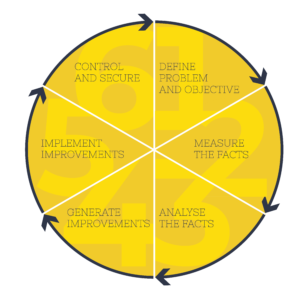Applying Lean principles in a Holacratic organization: putting theory into practice
Written by Luuk Hartsema on 4th May 2021
This is the third and final article in a series of three about how we practised with Lean principles. We established in our first article that we needed to find a form or shape in which we became able to address tensions that concern a chain of roles and circles. In our second article we dived into the need for prioritizing and aligning our efforts towards company goals by using the Policy-X Matrix. In this third article we put theory into practice.
Bouke van Zinderen, Lean thinking expert, was temporarily embedded in our organization. Using the observations Bouke shared, we started conversations throughout the organization to increase awareness about potential for improvement. Colleagues were often unaware that they could contribute to solutions for tensions other roles were struggling with to resolve.
Introducing a process model
To streamline the process, Bouke introduced the Kaizen circle. The Kaizen circle is a process model from Lean that entails an emphasis on problem analysis. It has many resemblances with other process models such as:
- Double Diamond framework
- Design Thinking Circle
- Human centered design process (HCD)
- The Lean Startup Model (BML)
- Agile lifecycle
- Plan, Do, Check, Act (PDCA)
The Double Diamond framework (Nessler 2018) is my personal favorite because it is the most detailed process model. But one should keep in mind to keep it simple. After all, these processes are there to give structure and keep everyone on the same page. You don’t want to exhaust colleagues with intricate complexities.
Make the process work for you
We made that mistake of giving lengthy explanations ourselves while we were introducing the Kaizen circle and learned quickly that it’s best to apply the process and let the team gain experience by putting the Kaizen circle into practice instead. Having a process and understanding it is important for teams. We’re a quirky organization that likes to adjust processes to our needs as we see fit anyway.
Often when processes do not immediately work the way you’d like them to, people tend to just stop the process altogether. It’s better to make an improvement effort, reap the benefits of what’s already there, and address the specific downsides of something that doesn’t work for you (yet).
Every now and then when Bouke was explaining Lean principles and the Kaizen circle to us, I had this feeling of being slightly annoyed with Lean. I sometimes feel the Lean community utilizes obscure and unique vocabulary while common language is available. That vocabulary makes it sound more complex and pretentious than needed. Don’t let that put you off, the bottom line is that Lean teaches methods that can get you to continuously improve. And getting 1% better each day is something that we care about.
Kaizen: learn fast and adjust quickly
The Kaizen process model has six stages to go through (Define, Measure, Analyze, Generate, Implement, Control). Although there are no rules set in stone, running through the process should go in a quick repetitive rhythm.
The Kaizen circle builds on the same paradigms as for example the “Build, Measure, Learn” cycle from the Lean Startup Model. It encourages people to learn fast and adjust quickly. Quick and small iterations enable fast learnings. It takes time and practice to get into that rhythm. It’s relatively easy to increase the size and complexity of a problem. It’s much harder to narrow it down to small manageable chunks.

This short video (90 seconds only) is a great way to explain the six stages of Kaizen.
Waste walks
When teams have the feeling that not all potential is utilized or that they work very hard but aren’t seeing results, doing a waste walk helps to explore improvement potential. This is a good starting point for a Kaizen improvement process.
What is waste?
Anything that doesn’t add value is considered waste. Taiichi Ohno, founder of the Toyota Production System, identified seven types of waste. In the context of software development, another type was added which resulted in the following acronym; DOWNTIME. Each letter represents a type of waste:
Defects: mistakes, bugs, errors, incidents and rework
Overproduction: make too much or too early
Waiting: waiting for previous step to finish
Non-Value Processing: work that generates little to no value
Transport: handovers between roles or teams
Inventory: large levels of work in progress, partially done work, unfinished projects
Motion: unnecessary amount of interactions, data sources, clicks
Employee Knowledge unused: colleague not using their full potential
These categorizations are there to give directions into typical areas for improvement potential. They support the creative process needed to enable teams to discover waste.
Finding waste is all about solving problems
Before you can fix a problem, you must see it first. However, the longer you’re in the same place, the more difficult it is to see the waste around you. During a waste walk the team comes together to make a joint exploration and search for waste within the current projects and overall in their work. Such an exploration makes waste visible again.
Finding waste is all about solving problems, therefore waste is welcome. Finding waste is an opportunity to fix what is causing the issue and make things better!
Improving quality
After multiple Waste Walks, teams within Spindle started several Kaizen improvement processes to improve their performance. One of the topics that sparked interest was the amount of issues deployed to our production environment that needed a hotfix. Every time an issue is deployed to production, our customers could potentially experience complications with our services. In the first half year of 2020, a total of 48 hotfixes had to be made by the Webapp team. This translated to an issue needing to be resolved every four days (which requires additional deployments, testing, and time).
Initially the overall belief was that improvements should be sought for in the process of the black box tester role. Black box testing is the last step to check quality before deploying the software to production. At the time, the black box tester was quite stretched for capacity. It appeared that colleagues were unaware of the actual activities performed by the black box tester. Next to that, they weren’t conscious of the impact that their own processes had on the effectiveness of the black box tester.
The combination of being accustomed to situations / working around the problems / reluctance to address the issues is quite a showstopper while trying to improve.
Insights gained
By applying Lean to look at the problems with a more holistic approach, many conversations, and going through a root cause analysis, colleagues realized that they had opportunities to bring about improvement. It became clear that the initial expectations for the blackbox tester were unrealistic and better collaboration and improvement was needed.
We also took this opportunity to give considerable thought to which roles are involved in the whole quality assurance process and who should participate in an attempt at improvement.
A closer look at the overall process
During the “measure the facts” stage of the Kaizen, the team decided to take a closer look at the overall process that was followed. A SIPOC diagram was used as a way to answer important questions such as:
- What are the essential steps within the process?
- What are the main inputs and outputs?
- Who are the key customers (internal and external)?
- Who are the key suppliers (internal and external)?
- What are the customer demands?
Asking and answering these questions encouraged team members to cooperate and communicate. This drastically improved our understanding of expectations and goals; what is the internal customer (e.g. colleague) expecting and what does the supplier hand over? Instead of trying to improve an individual circle, the team started to improve an overarching process involving a chain of circles and roles.
The quality assurance process was radically revised (a so-called Kaikaku) as a result of the quality assurance Kaizen. A new circle was created, the capacity for testing was increased, the team started to measure the facts, and tracked the amount of hotfixes. The Spindle Webapp team started to track the amount of hotfixes as well, measured the severity of each hotfix, and analysed the root cause.
Often this led to conclusions such as “Missed during development” or “Missed during QA (staging)”. In the latter case, the team also started to ask: Could the blackbox tester have picked this up or not? This led to the conclusion; we (Webapp devs) need to test more often and more thoroughly ourselves!
Celebrating success
As a result of the improvements and the increased awareness, we have seen a significant decrease in hotfixes. In the second half of 2020, the webapp team had to do 16 hotfixes. This is an improvement of 66% compared to the first half of 2020. The result was:
- Happier colleagues
- Boosted team morale
- Less time lost on additional deployments, tests, and fixes
- And a more reliable experience for customers
The enthusiasm of the Webapp team caught on and while the team was making these improvements, other teams also started to experiment with Kaizens and waste walks.
Every marriage has its struggles
In our first article, we used the metaphor of a happy marriage between Holacracy and Lean. One must admit that even in the best marriages struggles occur. Bouke really helped us to get started on our continuous improvement journey and together we discovered how Lean methodologies could enhance our Holacracy practices. We’re still learning every day and would like to thank Bouke for getting us on the right track.
A continuous effort to make it work is required. Success never presents itself in a linear motion and does not come effortless. We should continue to make waste visible and bring about these improvements. Being open to identify improvement potential as a team and implementing improvements in a structured way is something that has strengthened our processes, as well as our team. We hope that our journey has given you ideas on how to strengthen the process of your team.




Your thoughts
No comments so far